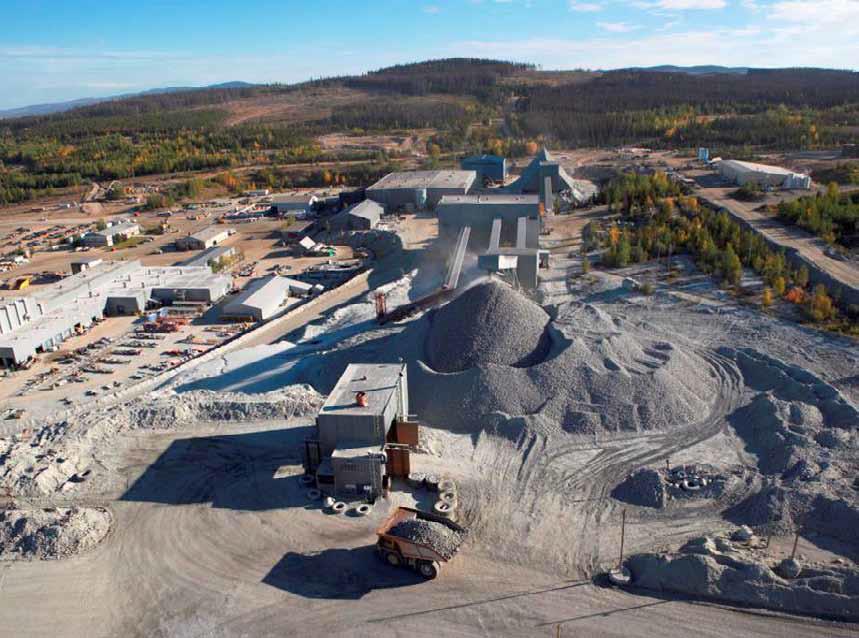
Taseko Mines is now engaged in the third phase of modernisation at Canada’s second largest open pit copper-molybdenum mine.
Taseko Mines Limited is a mid-tier Canadian mining company focused on mining operation and development in British Columbia. Headquartered in Vancouver, Taseko is the 75 percent owner and operator of the Gibraltar Mine, located near Williams Lake in south-central British Columbia, and Canada’s second largest open pit copper mine. First opened by Placer Development in 1971 it has been producing copper and molybdenum for some 40 years.
Taseko acquired the Gibraltar Mine in 1999, after it had been shut down when the price of copper fell below the cost of production. The mine had significant reserves, however, and plenty of scope for operational improvement and future exploration, so when the copper price began to rise again, Taseko re-opened the mine.
Gibraltar is located in an area with well-developed infrastructure. The property is accessible by a combination of highways and paved roads, and it is close to a rail network that provides service for shipment of copper concentrates through the Pacific Ocean port of North Vancouver. The mine is a 45-minute drive from local communities that provide goods, services and personnel.
When Gibraltar was restarted in 2004, the proven and probable reserves were 149 million tons and the mine life was 12 years. Today, the mine life has more than doubled to 27 years, following the most recent reserve update in March 2011.
The company is now engaged in the third phase of modernisation, after already investing over $300 million in the first two phases. Phase I, completed in 2008, increased mill throughput from 35,000 to 46,000 tons per day, by adding a new semi-autogenous grinding (SAG) mill, upgrading the grinding circuit, and installing a new flotation recovery system consisting of 10 modern flotation cells.
Phase II modifications allowed the new SAG mill to process up to its designed capacity of 55,000 tons per day, after the installation of a direct feed system to the mill, increasing the regrind capacity with a vertimill, installing cleaner flotation cells to improve metal recovery, upgrading the tailings pumping system by installing a second line independent of the first, commissioning a new pressure filter to increase concentrate drying capacity, as well as modernizing the mine equipment fleet with new equipment including a Bucyrus 495HR 60 yard shovel and four new 320 ton haul trucks.
In February 2011 Taseko committed to invest a further $235 million in the mine, to increase the design capacity of the mill from 55,000 tons to 85,000 tons per day. The Gibraltar Development Plan 3 (GDP3) will increase production by roughly 50 percent, boosting copper output to 180 million pounds a year.
In May 2011, Taseko announced that Ausenco Minerals and Metals had been awarded the engineering procurement and construction management (EPCM) contract for the million infrastructure portion of the GDP3 project. Ausenco is an international engineering and project management company, with vast experience in the mining industry on greenfield and expansion projects.
Based on an assumption of continuing strong metal prices, GDP3 is anticipated to have an internal rate of return of approximately 30 percent with a three year payback. “GDP3 is a good example of management's continued focus on unlocking the value of our long-life assets,” said Russell Hallbauer, president and CEO of Taseko. “This project's capital cost intensity of $7,800 per ton of daily mill capacity and $10,800 per ton including mine equipment is one of the lowest of any project being developed globally, and is reflected in the rate of return and quick payback.”
The plan is to construct a new 30,000 ton per day concentrator alongside the existing 55,000 ton facility. The project also includes the installation of a new molybdenum recovery facility which will increase molybdenum production by roughly 1 million pounds to almost 3 million pounds per year. Molybdenum recovery at Gibraltar continues to improve and is now approaching an average of 40 percent, up from the 25 percent achieved in 2010. This is a strong indication that the new molybdenum plant will add appreciably to total molybdenum metal production as a result of recovery improvement as well as increased throughput.
As part of this expansion, approximately $90 million of additional funding has also been earmarked for new mining equipment to ensure the mining operation keeps pace with demand from the upgraded plant. Construction began in the spring of 2011, with commissioning anticipated by the end of 2012.
On 12 March 2012, Taseko announced gross profit of $86.3 million and net earnings of $27.0 million for the year ended 31 December 2011. Revenues for 2011 were $251.9 million from the sale of 60.8 million pounds of copper and 974,000 pounds of molybdenum. Total production at Gibraltar (on a 100 percent basis) was 82.9 million pounds of copper and 1.3 million pounds of molybdenum.
"Construction of Gibraltar Development Plan 3 is progressing as planned, on time and on budget,” said Hallbauer. “All major equipment has been purchased for the concentrator, molybdenum plant and infrastructure, shipment of the long lead items has begun, foundations have been laid, and erection of the new buildings is well underway."
Alongside modernisation and expansion, Taseko has been increasing its workforce to keep pace with production. With the current mining boom in Canada, finding people to fill these positions may well pose some challenges, but VP of operations Dave Rouleau is optimistic. “We have been successful in finding the right people in the past,” he said. “The Cariboo region of British Columbia is a great area and helps attract good, skilled people. In addition, the investments we’ve made into this long life asset help draw the necessary workforce.”
Written by Carl Edison, research by Liz Jenkins
DOWNLOAD
 Taseko-AM-June12-Bro-s.pdf
Taseko-AM-June12-Bro-s.pdf













